An excerpt from the Annual Report of the Commissioner of Indian Affairs to the Secretary of the Interior for the fiscal year ending 1878, containing reports on the Indians at the Hampton Institute and a report by Lieut. Richard Henry Pratt regarding the recruitment of students for that school. Both reports discuss the education of students at…
Recruitment of Students for Other Schools
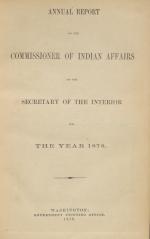
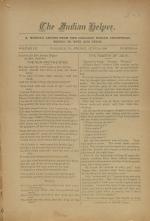
The first page opened with a poem selected “by Mrs. Pettinos,” titled “The Sun and the Wind,” followed by a conversation about the meaning of the 4th of July and how an Indian School student might be influenced to extend his time at the school instead of returning to the reservation. Page two included letters from Frank Lock (Sioux) on outing,…
![Armstrong Informs Pratt That Recruitment Can Begin [Version 1] Armstrong Informs Pratt That Recruitment Can Begin, 1878 [Version 1]](/sites/default/files/styles/views_taxonomy/public/image-document/YALE_WA-MSS-S-1174_b01_f011_7_1.jpeg?itok=83Ev-tG0)
Samuel Chapman Armstrong writes to Richard Henry Pratt informing him that Commissioner of Indian Affairs Ezra Hayt has approved Pratt's idea to recruit Indian youth to attend the Hampton Institute. Armstrong discusses the construction of a new building to house them, and asks Pratt to have photographs taken of the party for promotional purposes…
![Armstrong Informs Pratt That Recruitment Can Begin [Version 2] Armstrong Informs Pratt That Recruitment Can Begin, 1878 [Version 2]](/sites/default/files/styles/views_taxonomy/public/image-document/YALE_WA-MSS-S-1174_b01_f011_8.jpeg?itok=U2czM5aB)
Samuel Chapman Armstrong writes to Richard Henry Pratt informing him that Commissioner of Indian Affairs Ezra Hayt has approved Pratt's idea to recruit Indian youth to attend the Hampton Institute. Armstrong discusses the construction of a new building to house them, and asks Pratt to have photographs taken of the party for promotional purposes…
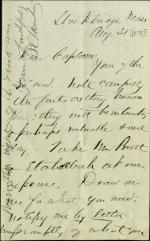
Samuel Chapman Armstrong writes to Richard Henry Pratt authorizing travel expenses for Mrs. Pratt and Etadleuh to recruit Indian youth for Hampton alongside Pratt. Armstrong also discusses some opposition that he and Pratt will face in their work.

Samuel Chapman Armstrong of the Hampton Institute sends Richard Henry Pratt encouragement ahead of a recruitment trip to the West, and suggests using photographs from Hampton to help in his efforts.
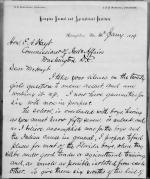
Richard H. Pratt states that he currently has 57 male students at Hampton and is looking to recruit 20 female students. He goes on to say that he plans to send most of the former Ft. Marion prisoners currently enrolled at Hamtpon on outings, believing that placing Indian students in white families where they will learn a trade will help give…
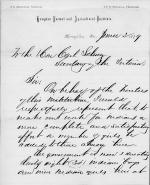
Hampton Institute Principal Samuel C. Armstrong states that they are currently educating 38 Indian boys and only 9 Indian girls, so he requests that they recruit 20 Dakota female Indian students. He requests that, if his wish is granted, Captain Richard H. Pratt be sent to secure the students and that he be allowed to bring back no more than…
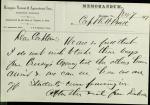
Samuel Chapman Armstrong of the Hampton Institute writes Richard Henry Pratt a memo stating that he cannot take some of the male students Pratt is recruiting at the moment due to capacity concerns.
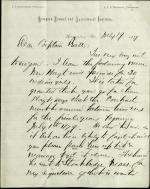
Samuel Chapman Armstrong of the Hampton Institute writes to Richard Henry Pratt informing him that Commissioner of Indian Affairs Hayt has promised a contract to recruit 20 Indian girls for the Hampton Institute. Armstrong discusses a desire to push Hayt for a larger contract for a higher recruitment number, and discusses logistics for Pratt's…
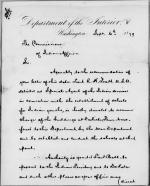
Acting Secretary of the Interior A. Bell informs the Commissioner of Indian Affairs that the War Department has transferred the buildings at the Carlisle Barracks to the Interior Department and that Special Agent Richard Henry Pratt is authorized to create an Indian school at the Barracks using the buildings. He also grants authority for Pratt…
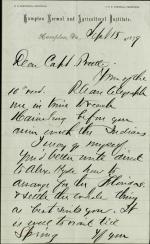
Samuel Chapman Armstrong of the Hampton Institute writes to Richard Henry Pratt discussing arrangements for Indians coming to either Hampton or Carlisle, as well as arrangements to transfer the Florida prisoners north. He also notes that Pratt can turn to the American Missionary Association for funding.
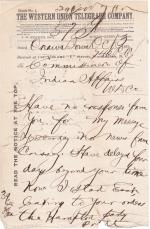
Telegram from Richard Henry Pratt in Onawa, Iowa, to the Commissioner of Indian Affairs following up on a previous message regarding his orders to recruit a party of students for the Hampton Institute. Pratt notifies the Commissioner that he has started his return journey.
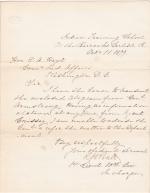
Richard Henry Pratt forwards to Commissioner of Indian Affiars Ezra Hayt a telegram sent by General Samuel Armstrong of the Hampton Institute. Armstrong telegrams Pratt asking whether he (Armstrong) is needed for a recruitment trip to Dakota, and Pratt forwards the telegram to the Commissioner for consultation.
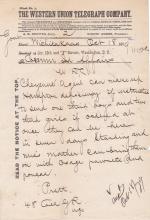
Richard Henry Pratt telegrams the Commissioner of Indian Affairs, informing him that the Cheyenne agent can supply students to make up the deficiency of students at Hampton, and should be instructed to send one third boys and two third girls. Pratt notes that these students could be escorted east by Alfred Standing and Sarah Mather, two…
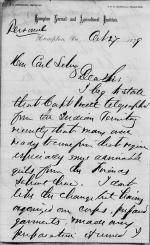
Hampton Institute Principal Samuel C. Armstrong informs Secretary of the Interior Carl Schurz that he received a telegraph from Captain Richard H. Pratt, who is currently in the Indian Territory. Pratt stated that there are many Indian girls in the Indian Territory who would be suitable students at Hampton. Armstrong states that, though he…
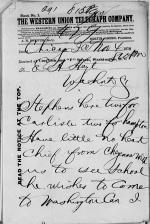
Agent Charles Crissey informs Commissioner of Indian Affairs E. A. Hayt that Agent Stephens is there with two students for the Carlisle Indian School and two for Hampton Institute. Crissey notes that he is also with Cheyenne Chief Little No Heart, who would like see the school. Crissey asks if he can bring Little No Heart with him.
Note…
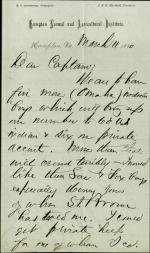
Samuel Chapman Armstrong of the Hampton Institute writes to Richard Henry Pratt discussing capacity issues at that school, including the arrival of five Omaha boys which increased enrollment at Hampton to its maximum. Armstrong also mentions Sac & Fox students and the enrollment of Indian students via both government and private support.
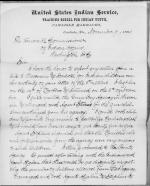
Richard Henry Pratt provides a report on his trip to Wisconsin and Dakota to recruit new students. Pratt notes that he first went to the Green Bay Agency and secured five students, but the enthusiasm among the parents was so strong that he could have easily recruited 25. Second, he visited the La Pointe Agency and instructed Green Bay Agent…
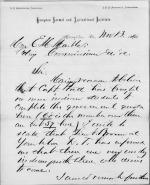
Samuel C. Armstrong informs Acting Commissioner of Indian Affairs E. M. Marble that Richard Henry Pratt is likely not bringing any new students to fill the quota of 68 Indian students at Hampton Institute. Armstrong continues to say that Lieutenant Brown at Yankton Agency knows of many Indian youth that would like to come to Hampton and could…
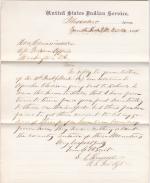
S. Russell, U.S. Indian Agent, informs the Office of Indian Affairs that he has had no success in finding students from the Apache Nation to be educated in eastern schools.
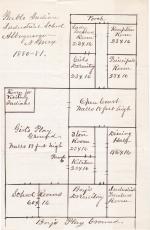
Sheldon Jackson encloses the plan for the Pueblo Industrial Indian Boarding School in Albuquerque, New Mexico to the Office of Indian Affairs. Jackson also states that he is having difficulty recruiting students for the Carlisle Indian School and the Hampton Normal and Agriculture School.
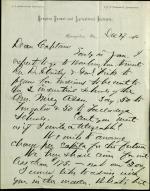
Samuel Chapman Armstrong of the Hampton Institute writes to Richard Henry Pratt requesting his involvement in lobbying for higher per capita funding for Indian students, and discusses recruitment for other schools.
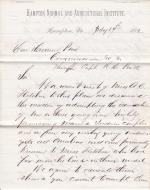
Samuel C. Armstrong writes that the Hampton Normal Institute is willing to educate three married Omaha couples along with three girls and one boy as government students if Alice C. Fletcher is able to bring them with the Sioux delegation going to the Carlisle Indian School. Richard Henry Pratt notes that he would be willing to accept married…
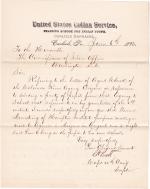
Richard Henry Pratt writes in regards to an inquiry from the U.S. Indian Agent of the Colorado River Agency to sending students to Carlisle. Pratt notes that Samuel C. Armstrong of the Hampton Institute is going to be visiting agencies in Arizona and recommends that the students from the agency instead be sent to Hampton via Armstrong's return…
